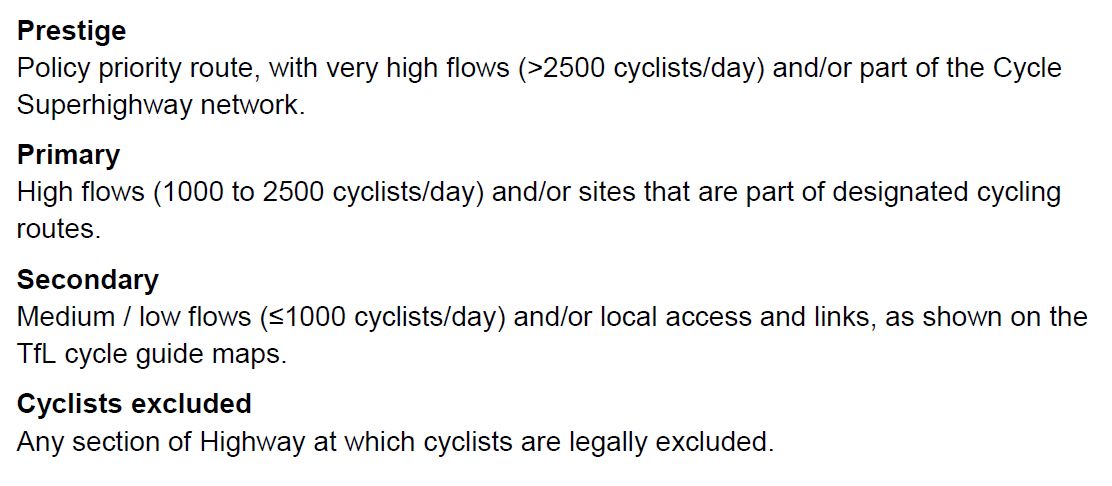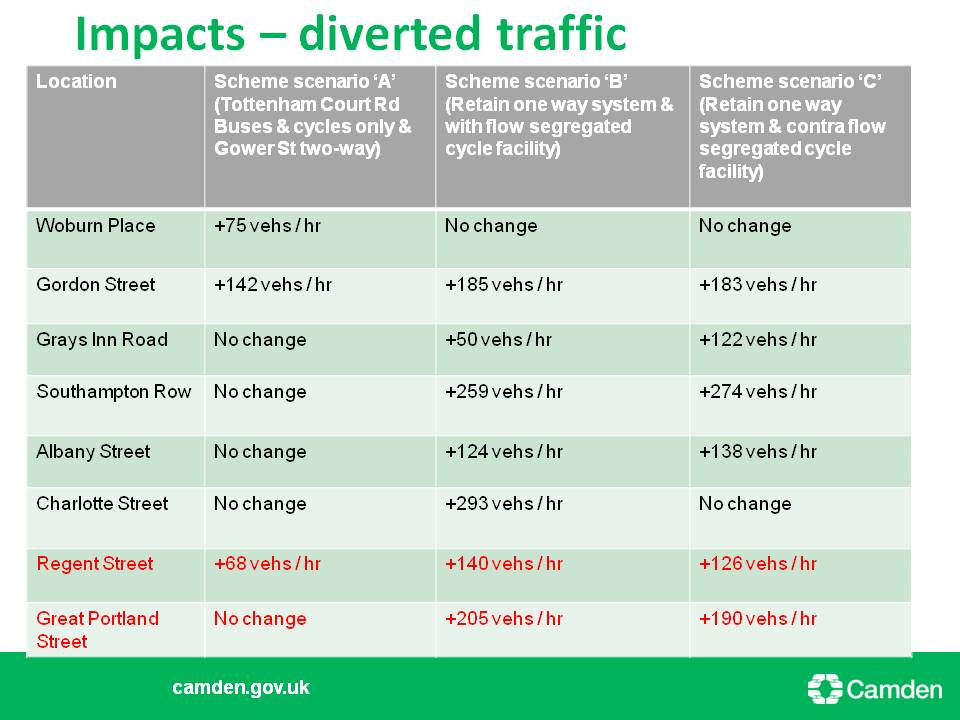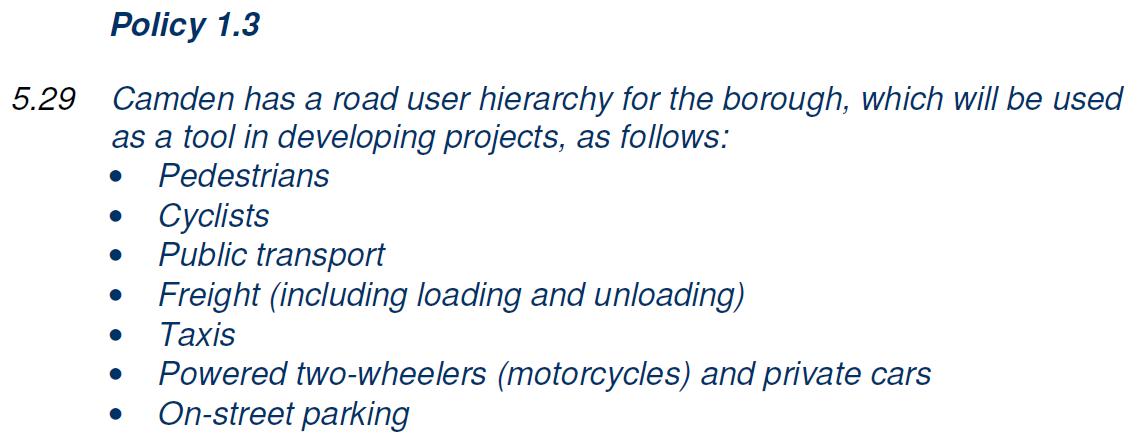This is a draft of the key points I plan to make in my personal response to the West End Project. The debates continue, with the deadline less than two weeks away. Camden Cyclists are working on a response – keep an eye out for this as well as reading the Fitzrovia News page linking to a variety of other articles. My own previous article, where I discuss some of these issues further, is here. You can respond to the West End Project here.
The West End project has always been defined by Camden as about gyratory removal: it was originally submitted to TfL in January 2010 under the title ‘Tottenham Court Road/Gower Street 2-way traffic’. Like the Vole, I’m sceptical of the intrinsic value for cycling of removing gyratories (a scepticism also expressed in the draft London Cycle Design Standards).
However, gyratory removal may well be a good idea for other reasons, and while I write this from a cycle advocacy perspective, I don’t expect every scheme goal to be about delivering for cycling. But I do expect schemes that impact core cycle networks to provide adequately for cycling, whatever the overarching framework. And if that really isn’t possible, then yes, maybe gyratory removal isn’t the right headline objective. However, I’m optimistic that Camden can still sort this scheme out by combining gyratory removal with good cycling conditions – it’s just not in the current plans.
For some local authorities, adequate cycle provision might be a step forward. But in the case of Camden (which won a recent London Cycling Campaign Award and which lists cycling as second from top in a Road User Hierarchy) I’d expect good, so it worries me greatly that this project is not even adequate for cycling. This is why (refer to links at the top for more details):
(a) On Tottenham Court Road, the plan is for cycling with high volumes of buses plus what may turn out to be fairly large amounts of other motor traffic. This will not enable inclusive cycling and is in excess of the LCC Policy Guidelines. Tottenham Court Road and/or Gower Street are on the Central London Grid, the ‘prestige’ or at least ‘primary’ cycle network as defined in the draft London Cycle Design Standards (LCDS).
(b) While TCR is – in my view – being optimised for two-way bus priority, Gower Street is being given over to two-way private motor vehicle traffic. Camden is trying to fit in cycling, but I’m really not convinced there is space for good facilities (2m each way minimum, with proper separation), if this relatively narrow street remains a movement corridor for private motors. I saw suggestions this week for cycle lanes here including options for (i) 1.75 mandatory (painted) lanes on either side or (ii) armadillos at 1.5m out from the curb, with advisory painted lanes somewhat outside that. Engineers are trying, but these aren’t adequate solutions. Not to mention that pavements should be wider too in this busy tourist/university corridor.
(c) Worryingly, while neither TCR or Gower (one or both are key direct routes on our core cycle network) will be of adequate standard, other core cycle routes will be negatively impacted by these plans. While I acknowledge an increase in two-way cycling in side streets will be useful, what about other core routes? In particular I’m worried about:
i. Tavistock and Torrington Place cycle tracks (Grid and London Cycle Network – prestige or primary route). These tracks are well over capacity, to the extent that despite their obvious popularity they are now limiting cycling uptake. A distinguished Emeritus Professor at UCL (ironically, who has done important work related to cycling) told me he was not able to cycle near his home and work for this reason, although knee problems meant that cycling could substantially improve his transport options. As Camden Cyclists have argued, cyclists now need a bigger share of the road, as do pedestrians. One way of achieving this would be to use filtering to remove through motor traffic, quietening the street enough that cyclists could without fear use the full width of the carriageway. However, the West End Project plans do nothing to improve this route for cycling – in fact, far from filtering motor traffic out, they will route more through motor traffic along here. With even more motors to accommodate, cyclists will continue to be squashed into narrow tracks till 2018 and beyond.
(ii) Gordon Street (on the Grid – so also a prestige or primary route). Gordon Street will see a big increase in rat-running motor traffic as part of the West End Project Plans, making it less safe and pleasant for cycling (when it really needs urgently to be filtered to stop rat-running). This will also impact East-West cycle traffic along Tavistock Place, where cyclists are already put at risk at junctions by inappropriate levels of through motor traffic.
(d) There are also other problems, like New Oxford Street and Princes Circus, where plans offer little to cycling. I could go into much more detail. But the reasons above are key to why I don’t think these plans offer adequate space for cycling. Core routes won’t be good enough – busy with motors (TCR and Gower) and substandard lanes (Gower), or are effectively being worsened. The ‘prestige’ and ‘primary’ networks here will be inadequate to poor and I don’t think it’s good enough to be asked to wait until after 2018 to see whether they can then be improved.
It’s important to note that currently this scheme doesn’t fit with Camden’s own Transport Strategy. The Strategy has some good headline objectives, and the objective related to congestion and efficiency (which is often where motor dominance is smuggled back in) includes a explicit commitment ‘to limit the demand for motorised travel by enhancing facilities for walking and cycling’.
Camden’s Transport Strategy has a Road User Hierarchy: but as far as I can see here, buses are being given priority in Tottenham Court Road and private motors in Gower Street, one or both of which are on the core cycle network. My own suggested fix of closing Gower Street to through motor traffic (there are other possible fixes that I’d support) would mean that by contrast, TCR is prioritised for buses and Gower for cycles and pedestrians. Filtering Gower would allow pavements to be widened rather than narrowed as in the current plans, and would make Gower a much more pleasant place for pedestrians to be in and travel through.
Moreover, Camden’s Transport Strategy suggests that the big improvements that need to be made are with respect to cycling. In respect of buses, the target is to maintain current excess waits, while for walking, the target increase in mode share seems already to have been achieved. By contrast, the cycling target is very ambitious, an increase from 3% currently to 8% of all trips by 2025/26. (For comparison, Hackney, where cycle commuting levels are highest in London, only 5% of all trips are currently cycled). As the latest figures (2008-9 to 2010-11) show Camden’s cycle mode share still at 3%, this implies the borough needs to almost triple the proportion of trips cycled in the next ten years.
How big a change does this imply? Well, between 2001 and 2011, cycling’s commute mode share in Camden went from 4.1% to 7.1%. Assuming a similar rate of growth among all cycle trips during that earlier period (probably optimistic , given it’s proved easier to increase commute trips than other trips), we need the current rate of growth for cycling in Camden to rise from 73% over the last ten year period, to 167% over the current ten year period.
This is challenging – current infrastructure such as Tavistock/Torrington is inadequate to cater even for current numbers, let alone an acceleration in the rate of growth. So according both to Camden’s road user hierarchy, and its mode specific targets, cycling should be prioritised. But even sympathetic commentators agree that this scheme offers relatively little for cycling (compared with the improvements for bus priority and to a lesser extent in my view, for walking).
Camden’s officers and councillors do seem genuinely surprised by the criticisms the West End Project has got from a cycling perspective, and want to sort this out. They were kind enough to invite me and others to a workshop earlier this week to discuss the plans further. I appreciate this. And in part, the criticism is due to the ramping up of ambitions over the past few years – which boroughs like Camden have themselves contributed to. However, this rise in ambition has meant that previously produced plans and strategies – written in good faith by Camden and other organisations – are no longer good enough.
I’d like Camden to acknowledge this scheme doesn’t do enough for cycling and to revise it so the core cycle network here (including the Tottenham Court Road and/or Gower Street alignment, plus the Tavistock route and Gordon Street, at a minimum) will reach acceptable standards by or before 2018. This means providing for inclusive cycling (in line with the LCC Protected Space thresholds) including high quality infrastructure where needed that caters for big increases in capacity.
My personally preferred solution would include removing through motor traffic from Gower Street. My reasons: this is an option that can be easily added on to the existing plans, benefiting pedestrians (at the top of Camden’s hierarchy) and having no negative impact on the bus priority plans, obviously important to Camden. Filtering Gower Street affects the Strategic Road Network, so it would be helpful if the GLA and TfL were to support cycling here by asking Camden to include filtering Gower within a revised scheme – perhaps as a ‘trial’ add-on to be evaluated over six months. However I would also support other options that would meet the same criteria, while maintaining or improving the scheme’s existing pedestrian benefits.
I believe Camden officers and councillors have goodwill and laudable ambitions for cycling: I hope that revised plans can be developed that fulfil these.





Very constructive and perceptive comments Rachel. You take what is I think a realistic perspective of the political position we and Camden are in (i.e. in public politics, not the sometimes counterproductive politics of cycle campaigning) while offering a positive way forward. Thanks for bringing some much-needed clarity to the discussion.
On Torrington/Tavistock, we have reason to believe that major improvements could follow the finalisation of the West End project plans – despite the additional difficulties that it seems to bring.
So that’s a “jam tomorrow” argument: we have to take it on trust that if we accept a bit of a rubbish scheme here we can expect our reward in the future. But politicians operate on very short timescales and are “here today, gone tomorrow”. In my experience it’s unwise to buy this line.
“I believe Camden officers and councillors have goodwill and laudable ambitions for cycling”
Maybe, but the reality on the ground is very different. Just look at Holborn Circus, Holborn Gyratory, Tavistock Place, Camden High Street, Swiss Cottage; They have never ever prioritised active travel.
It is much wiser to acknowledge that the Council’s goodwill and ambitions are way below par and fight hard against their reactionary, 20th century mindset.
The sycophantic tactics of the Camden Cycling Campaign will bring us ten more years of failure.
Andrea – that’s a bit too harsh on both Camden Council, and Camden CC. Up to last year, Boris’ ‘smoothing traffic flow’ policy effectively ruled out any prioritising of active travel – and Camden Council have been designing this scheme – and CCC campaigniing on it, on that basis. What’s important now is that both the Council and CCC take advantage of the political space that LCC has created with its ‘Go Dutch’ campaign to improve the scheme so that it really does prioritise active travel.
The plans seem to prioritise two way bus traffic over all else – I suggest that if the bus lanes are removed (they are fairly ineffective in reducing delays for buses as they are frequently congested with buses and taxis themselves) and one way system is maintained there is scope to reduce the number of motor traffic lanes and provide good quality footways and cycle paths.
Pingback: Camden’s West End Project consultation | Fitzrovia News